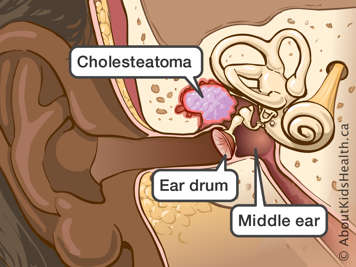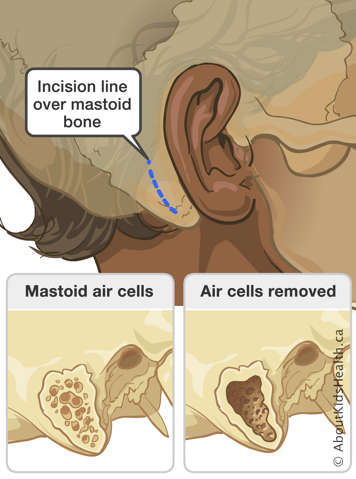Your child needs an operation to take away part of the bone from behind the ear. This operation is called a mastoidectomy (say: MAST-oid-ECK-toe-mee). This operation will be performed by an otolaryngology (say OH-toe-lar-ing-olo-gee) doctor.
This brochure explains what will happen during the operation and how to care for your child at home. Use this information to explain to your child what will happen, using words they can understand.
Important information
My child's otolaryngology doctor is:
The doctor's phone number is:
The otolaryngology clinic nurse's number is:
Why a mastoidectomy is needed
The bone behind the ear is called the mastoid bone (say: MAST-oid).
Your child may need a mastoidectomy because of one of these problems in the mastoid bone:
- infection
- cholesteatoma
Infection
The mastoid bone contains hollow spaces called air cells. The air cells are connected to the middle ear, which is the part of the ear behind the eardrum. Sometimes, infections in the middle ear can spread to the air cells in the mastoid bone.
If your child has too many infections in the mastoid bone, the bone can become soft. If this happens, that part of the bone must be taken away. Taking away the diseased part of the bone does these things:
- It stops the spread of infection.
- Sometimes the hearing is slightly poorer after the surgery but the procedure stops any more damage to the ear and to your child's hearing.
Cholesteatoma
A cholesteatoma (say: KOE-less-tee-uh-TOE-ma) is a growth in the middle ear. Layers of skin build up in the middle ear. If a cholesteatoma gets too big, it can damage your child's ear or their hearing.
If your child has a cholesteatoma, they may have some or all of these symptoms:
- bad-smelling fluid leaking from the ear
- full feeling in the ear
- pressure in the ear
- loss of hearing
These symptoms can also be caused by other problems. Your child may need to take several tests to find out what is causing the symptoms.

A cholesteatoma can spread into the mastoid bone. If this happens, your child will need a mastoidectomy to stop any more damage to your child's ear or their hearing. Sometimes, removing the cholesteatoma may make the hearing slightly worse but often not enough for the child to notice.
Before the operation
Several hours before the operation, your child will need to stop eating and drinking. The doctor or nurse will tell you when your child must stop eating and drinking.
Write this information down here:
- The date and time of the operation:
- When your child must stop eating:
- When your child must stop drinking clear fluids:
- Other things to remember:

The operation takes about three hours
Your child will have a special "sleep medicine" called a general anesthetic. This will make sure that they sleep during the operation and do not feel any pain.
An otolaryngologist/head and neck surgeon will do the operation. An otolaryngologist (say OH-toe-lar-ing-olo-gist) is a doctor who specializes in problems with the ear, nose and throat.
The doctor makes a cut behind the ear and takes out the affected mastoid bone. Then the doctor stitches the skin closed. The doctor may put a drain behind the ear to stop fluid and blood from collecting around the cut. This drain will be taken out before your child goes home from the hospital.
The operation takes about three hours.
After the operation
After the operation, we will take your child to the recovery room, also called the Post Anesthetic Care Unit (PACU). This is where your child will wake up. Your child will stay in PACU for about one hour. We will then move your child to a room on the nursing unit.
You will be able to see your child as soon as they are fully awake. A volunteer from the Surgical Waiting Room will bring you to see your child.
Your child will have an intravenous tube (IV) in their arm. We will give your child medicine and fluids through the IV until they can drink easily.
Your child may have a gauze bandage on their ear or around their head. Your child's doctor will take the bandage off the day after the operation. If your child has a drain, the doctor will remove it at the same time.
Your child's ear may also be packed with a ribbon or sponge pack which will be taken out during a clinic visit after the operation.
Your child may feel dizzy
Your child may feel dizzy after the operation. You or another adult should be with your child when they get out of bed on the day of the surgery.
Taking care of your child's pain
If your child has pain after the operation, we will give them pain medicine, either through the IV tube in their arm or by a pill or liquid to swallow. You know your child best. If you think your child is in pain, tell the nurse.
Eating and drinking
Your child will probably ask for sips of water two to three hours after the operation. After your child can drink, we will start adding their usual food.
Your child will stay in the hospital overnight
You will be able to stay overnight with your child in their room.
Caring for your child at home
Caring for your child's incision
Your child may have a small gauze bandage over their ear. Please keep this bandage on for one or two days after going home.
Do not let the cut behind your child's ear get wet. Try not to get water in the ear. Your child can have a bath, but do not wash your child's hair until the doctor sees your child.
Pain management at home
Follow these instructions when your child goes home after the procedure.
You may give your child medicine for pain.
You may receive a prescription for pain medication before you leave the hospital. Follow the dosage instructions given to you by the pharmacist. Although these prescription pain medications can be beneficial, they are also potentially very dangerous if not used properly.
When using these medications, if you notice any changes in either breathing or level of drowsiness that concern you, stop the medication and seek medical attention. If your child is unresponsive, call 911 immediately.
Do not give your child over-the-counter medicine that may have a sedative effect (makes people sleepy) while giving the prescription for pain medicine. Examples of these medicines are decongestants and antihistamines. Discuss these medications with your pharmacist.
You may give your child acetaminophen if they have pain. Give the dose printed on the bottle for your child's age. Do not give your child ibuprofen or acetylsalicylic acid (ASA) for two weeks after the surgery. These medications could increase your child's risk of bleeding after the operation. Check with the nurse or doctor first before giving these medicines to your child.
Activities
Do not let your child play contact sports like hockey or soccer until the otolaryngology doctor says it is OK. It is usually at least two weeks after the operation before a child is well enough to play contact sports.
Do not let your child go swimming until the doctor says it is OK. Usually, children are instructed to wait about six weeks after the operation before they are allowed to go swimming.
Going back to school or day care
Do not let your child go back to school or day care until after your follow-up appointment. High school students can usually attend classes after three days if they are feeling well.
Your child will need a follow-up appointment
The otolaryngologist will need to see your child again for a follow-up appointment. This appointment will be one or two weeks after the operation.
Write the date and time here:
During the appointment, the doctor will do these things:
- Check your child's ear to see how it is healing.
- Remove the packing from your child's ear.
- Tell you when your child can start to play sports again.
When to call the doctor
These are signs that there is a problem:
- fever of 38.5°C (101°F) or higher
- blood or fluid leaking from the ear for more than two days
- vomiting (throwing up) that does not stop
- pain that gets worse
- redness or swelling around the ear and the incision
- the packing falls out of the ear
If your child has any of these signs, call your child's otolaryngologist, the otolaryngology clinic, or your family doctor right away.
If this is an emergency, or if you are concerned about your child's condition, do not wait. Take your child to the closest emergency department right away.